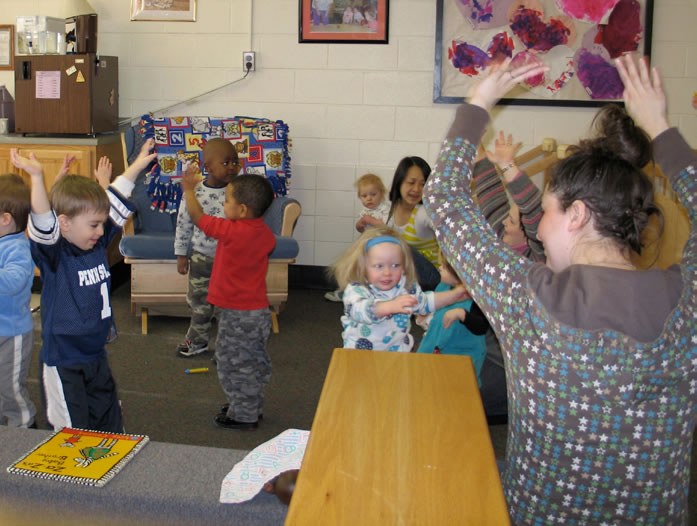Part 2 of a two part series on self regulation. Setting up the learning environment to support the development of self-regulation skills. Although most children acquire self regulation through positive early experiences, experts suggest that self regulation is a skill that needs guidance or to be taught.

Children need adults who understand child development
Adults who know general milestones and abilities in child development have accurate expectations of what children can do. When the development of each child is supported, tasks and skills in self regulation are more manageable.
It is advantageous to plan ahead in guiding certain developmental skills that are not yet present for children. For example, knowing an infant cannot yet talk, you can plan ahead to respond to her needs by being attentive, knowing other signs she may communicate with, and modeling language.
As complex developmental skills increase, so will children's skills in managing self regulation. *Go to your state's Department of Education, where early childhood resources and guidelines can be found.
Intentional practice
For preschool-age children, try games where control and listening are needed, such as red light/green light. For toddlers and younger preschoolers it is helpful to teach games, songs, and finger plays that use self control, such as making voices loud then soft, adding motions to a song in place of the words, or moving to different tempos of music.
Children need supportive environments
Research has shown that early positive attachments support self regulation. In addition to positive attachments with adults, young children need to feel comfortable, engaged, and loved in their environment.
In looking at the environment, provide experiences and materials that are inspiring and appropriately challenging. Allow for adequate freedom of exploring so children can experience problem solving and self choice. Mix in balance and structure of routine, which supports predictability and provides reassurance for young children. The child's view of the environment should be, "I belong here." Consider posting photographs of families and having pictures and materials that interest the child or that the child has helped create.
Setting up your environment
Think about light, color, sound, walls, room arrangement, furniture, and temperature; all of these can affect children. Be sure to provide quiet spaces, private spaces, personal spaces, spaces pleasing to look at, space for physical movement, space for sensory motor (sand/water), mirrored spaces, and spaces that encourage collaborating. And remember to consider the children's personalities, home life, and family/culture when developing environments.
Intentional practice
Anticipate transitions or situations that may add a challenge for children and plan ways to help. For example, Sue has a difficult time transitioning inside from outside play time. Give time for Sue to know the change is coming. Try interacting with her before the change occurs. Prompt Sue to think about what she will do when she gets back inside and possibly offer a job, such as carrying the jump ropes inside.
Children need practice in self awareness
When children learn about their own self awareness, they can then begin to understand how to use self control, reflection, and planning. They also can begin to understand the awareness of others. The discovery of self awareness is strongly connected to self regulation. Infants begin to learn about self awareness when their needs are met. Young children are learning about self awareness when they start to learn about controlling their body. Older children learn more about self awareness by interacting with and watching the actions of others.
Intentional practice: Provide practice in self-awareness
- Ask children open-ended questions that encourage them to reflect and process their ideas
- For very young children, provide words for experiences, feelings
- Allow children to plan and add input to activities and projects
- Provide problem-solving strategies to children
- Offer choices instead of demands
- Practice role playing
- Provide activities for practicing physical control: stop and go games, listening games
- Provide activities for partnering
- Provide journal materials
- Read stories that relate to self and self awareness
Embracing your role in understanding the development of self regulation not only benefits children's future school readiness and success, but also plays a key role in the their overall achievements and to their quality of living.
The influences you support in self regulation can make a positive difference each day.
References
Bodrova, Elena, and Deborah Leong. "Vygotskian/post Vygotskian Research on the Development of Children's Intentional Make-Believe Play." National Association for the Education of Young Children, National Conference session 2007, Pittsburgh, PA.
Fong, Vicki. 2007. "Self-regulation abilities, beyond intelligence, play major role in early achievement." Summary of article by Blair, C. and R. P. Razza in Child Development 78 (2). retrieved April 3, 2007
Perry, Bruce D. "Self Regulation: the Second Core Strength." Retrieved August 13, 2007
Claudia C. Mincemoyer, Ph.D., Better Kid Care Program Director
341 North Science Park Road - Suite 208, State College, PA 16803
Phone: 1-800-452-9108 * Web site: www.betterkidcare.psu.edu
Supported by funds from the Office of Child Development and Early Learning, a joint office of the Pennsylvania Departments of Education and Public Welfare.
TIPS #1106

